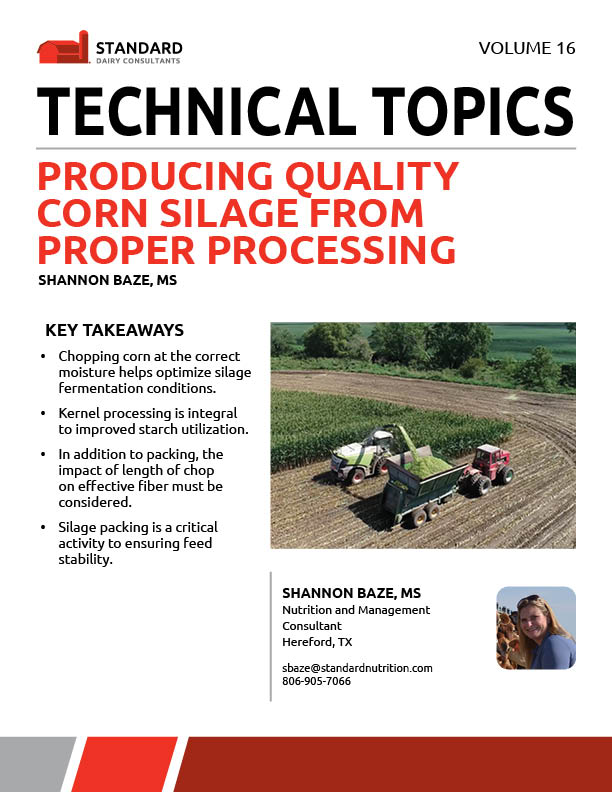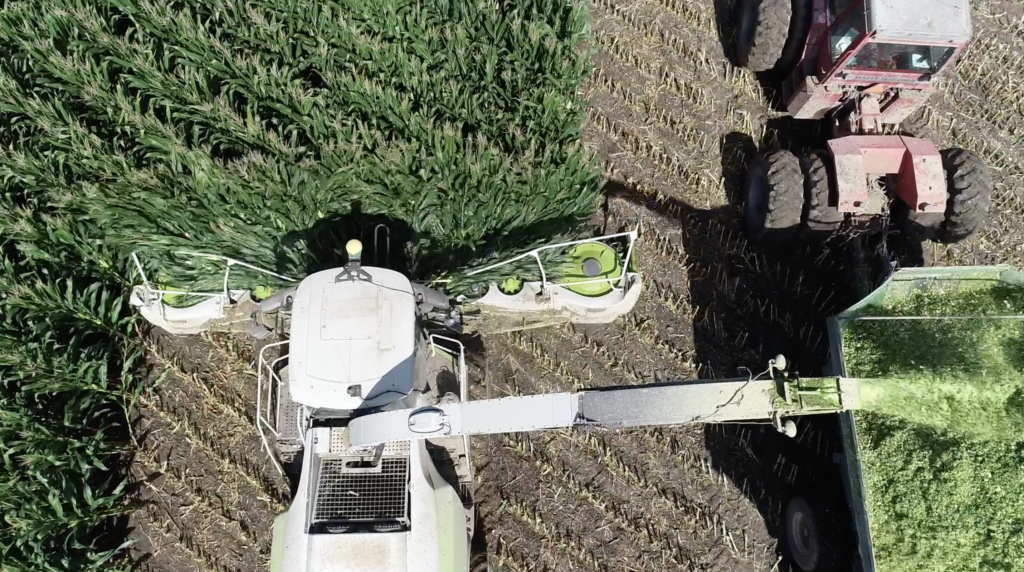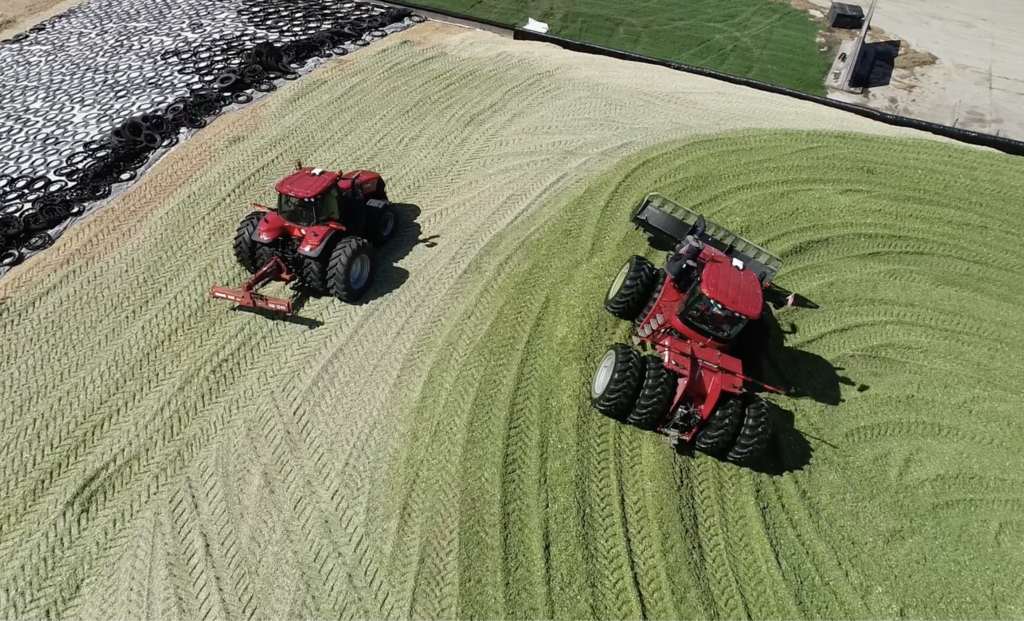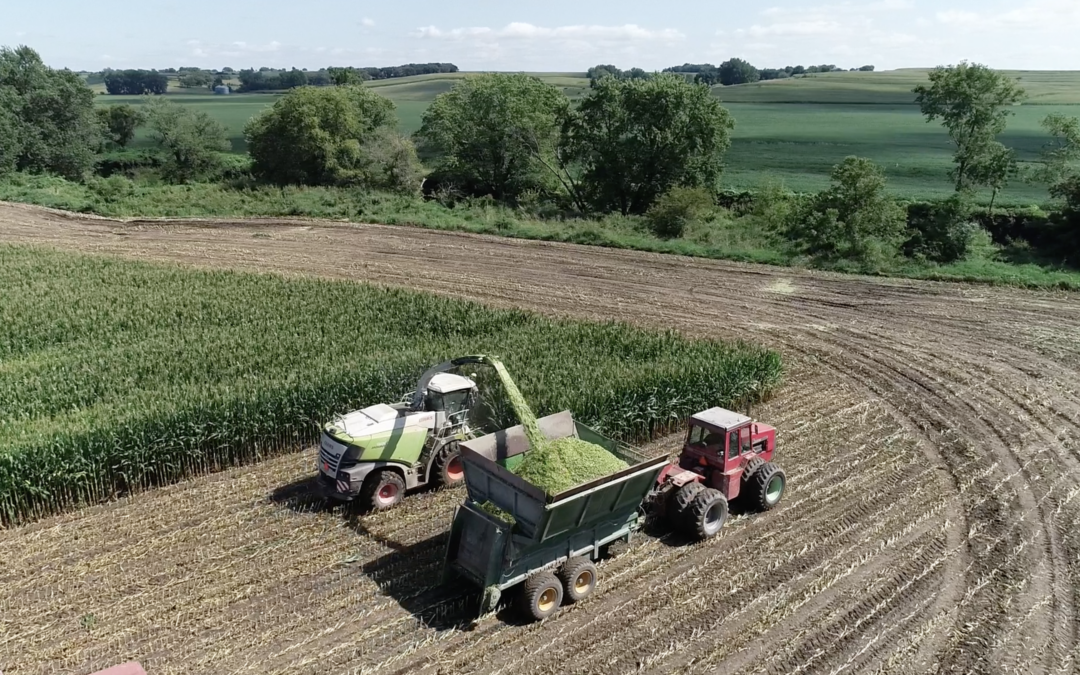Written by: Shannon Baze
KEY TAKEAWAYS IN THIS ISSUE OF TECHNICAL TOPICS:
- Chopping corn at the correct moisture helps optimize silage fermentation conditions.
- Kernel processing is integral to improved starch utilization.
- In addition to packing, the impact of length of chop on effective fiber must be considered.
- Silage packing is a critical activity to ensuring feed stability.

Once again, it’s time to harvest what some consider the most critical crop to a dairy, Corn silage!
With the environmental variables affecting the quality of the corn silage that we can’t control, such as the weather (wind, rain, or hail) and extreme temperatures, we must focus on variables that we can control such as 1) chopping at the proper moisture, 2) kernel processing 3) particle length, and 4) packing of the silage.
For all dairies, focusing on these four essential steps is key to feeding quality silage all year long.
KERNAL PROCESSING
Kernel processing is the next critical step and measures the extent of kernel breakage within the silage. Breaking the kernel into pieces results in improved starch digestion and improved starch utilization by exposing more starch granules within the kernel to microbial fermentation. A simple method to determine proper kernel processing is a field monitor system and only requires a 32oz cup. Fill the cup with fresh corn silage and then spread the contents on a flat surface for visual inspection. There should be no more than two half or whole kernels in the silage from the cup. If you spot any additional kernels, let the chopper know immediately so proper adjustments to rollers can be made. The ideal range is generally 1 – 3 mm, while the tighter, the better. To maintain a good score, check routinely or whenever switching fields since there can be variations in maturity and moisture.
A second popular method to determine the Kernel Processing Score (KPS) is the test offered by your local lab, which may take longer for results, but are more accurate than a field test. Developed by Dr. Mertens from the US Dairy Forage Research Center, the corn silage sample is dried and shaken through a series of nine screens. The portion of the sample that passes through a 4.75-mm screen is collected and analyzed for starch as a percentage of total starch in the silage sample. The level of KPS to maximize energy efficiency and minimize fecal starch should be greater than 70 percent. Although harvest time is the ideal time to impact KPS, research suggests that KPS improves over time from fermentation.
CHOPPING AT THE RIGHT MOISTURE
Chopping at the proper moisture is the first step to putting up quality silage. If chopping at too high of moisture, there is the risk of nutrients seeping away and dealing with the environmental effects of the effluent from the storage unit. Chopping too dry will harden your kernels and decrease starch availability. With drier silage, packing becomes a challenge which introduces the potential for fermentation problems. The ideal moisture to chop corn silage falls between 68% to 62% (32% to 38% dry matter). Within this range, fiber quality is optimized, and the moisture content allows for good packing and fermentation, promoting increased starch digestibility and silage preservation.

PARTICLE LENGTH
A third factor impacting quality corn silage is particle length or theoretical length of chop (TLC). The idea is to set the feed roll at ¾ inch, which is longer than the ⅜ to ½ inch setting for non-kernel-processed corn silage. The feed roll speed determines TLC; slowing down feed rolls produces a shorter chop length; therefore, less forage is pushed through the chopper. The fewer tons/hr. processed requires a longer time to chop but adequately processes the silage. The longer time will pay back in feed-out of well-processed, higher quality corn silage, which may bring more milk production. The TLC also depends on the silage dry matter (DM) of the silage at the time of chopping. The wetter the silage, the longer the chop length can be.
A common method used, on farm, to determine the particle length is the Pen State Particle Separator. If corn silage is the main forage ingredient in the ration, there should be no more than 15% of the silage in the top sieve, the middle sieve 45-65%, 20-30% in the second lower sieve, and no more than 10% in the bottom sieve. The more corn silage makes up in the ration, the more that proportion must be in the two middle sieves, and less in the bottom, to ensure there is enough physically effective fiber (peNDF). When particles are too long, the cows are more likely to sort the ration. Shorter chopping during harvest improves packing and fermentation. Still, on the flip side, it is believed that smaller particle length decreases chewing and buffer secretion, lowering rumen pH, which may decrease milk fat percentage. These events are precipitated by diets low in peNDF. Current recommendations suggest that rations fed to lactating cows must contain a minimum
of 25% neutral detergent fiber (NDF). Some research has shown that increased consumption of NDF on shorter particle length corn silage diets resulted in less sorting and greater consumption of other higher fiber particles in the ration. Overall, a reduction in particle length can increase DMI, reduce sorting, and lead to more consistent feeding and milk and component production.
SILAGE PACKING
The last step to proper silage processing is packing, one of the most controllable variables. Putting someone you trust on the packers can ensure proper packing. The general rule of thumb is for every ton of silage chopped per hour, 800#’s of weight on the packing tractor is needed. Whenever possible, have the packer go back and forth and avoid turning the pack tractor on the pile. If there are any doubts, your nutritionist can help direct you to any one of many trusted companies that have literature and videos that can help train your employees.
Pushing all the air out of the silage is essential to proper fermentation. Using a research-proven inoculant is another added protection that your nutritionist can help you with. The inoculants on the market today are oxygen scavengers and can help to consume as much oxygen left in the silage pile to ensure even better-fermented silage. Lastly, cover your silage pile or bunker immediately. Use oxygen barriers and additional layers of plastic as well as tires to cover every spot one will fit.

SUMMARY
Putting a plan together with your employees and your nutritionists will ensure that everyone is on the same page when chopping starts. Make sure all your equipment is in working order and that everyone knows the tasks at hand so nothing is missed. Controlling these variables, chopping at the right moisture, kernel processing, particle length, and silage packing, can help you produce the quality silage that you can feed all year long.
Where’s the Starch? The Importance of Corn Silage Fermentation on Ruminal Starch Digestibility
Written by: Chad Jenkins, PhD
In addition to the preservation of corn silage for a year’s worth of feed-out, the ensiling process also plays a critical role in increasing the digestibility of starch in the rumen. Within the endosperm of the corn kernel, proteins called prolamin (zein) encapsulate starch granules. When corn silage undergoes the fermentation process, these proteins are subjected to proteolysis, or “breakdown”, resulting from the action of bacteria. Breakdown of the prolamin-protein matrix allows for easier access to starch granules by rumen microbes when the corn silage is consumed, which leads to improved digestibility. Improvements in ruminal digestibility equate to greater energy value of the starch (more VFA production), reduced fecal starch, and ultimately, milk yield.
The corn silage best practices discussed above are a great start to ensuring improvements in starch digestibility, however, this process requires time after the final tire has been thrown onto the pile – this is one of the reasons nutritionists recommend up to three months ensiling time before opening a new silage pile or bunker. In fact, in a well-constructed silage pile, starch digestibility may continue to improve throughout the course of the year. One “clue” to changes in starch digestibility will come by way of feed analysis. As prolamin continues to break down, soluble protein (ammonia) concentration will increase in the feed. Increasing soluble protein can be a good marker for improvements in rumen starch digestibility (this is also the case for high moisture corn). If notable changes in starch digestibility are observed, it is prudent to make adjustments to rations accordingly. For example, less supplemental corn may be required to provide an equivalent amount of energy as starch digestibility improves.
Making the extra effort to ensure all of the “little things” go right during corn silage harvest add up to significant improvements in silage quality, particularly in the digestibility of starch. Improved starch digestibility allows for more flexibility in the provision of energy-dense feeds, which can lead to reduced feed costs, improved milk production, and overall efficiency of the dairy.


